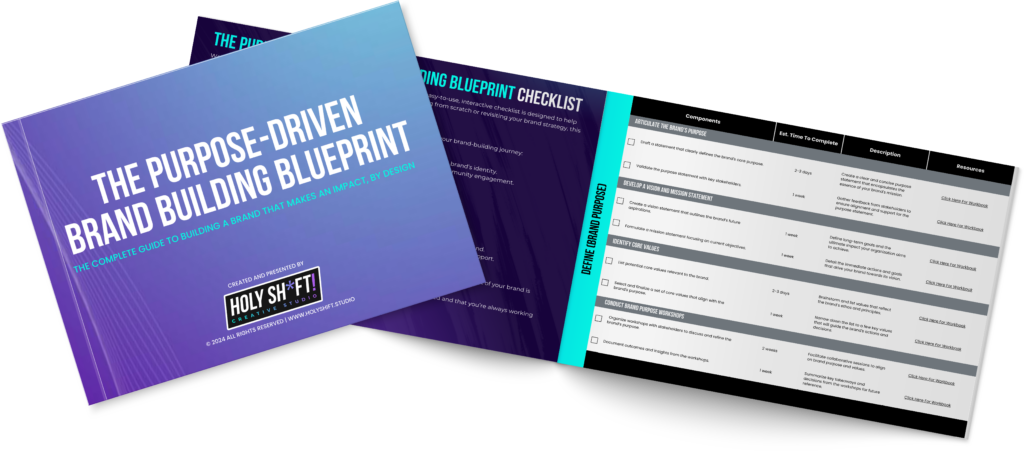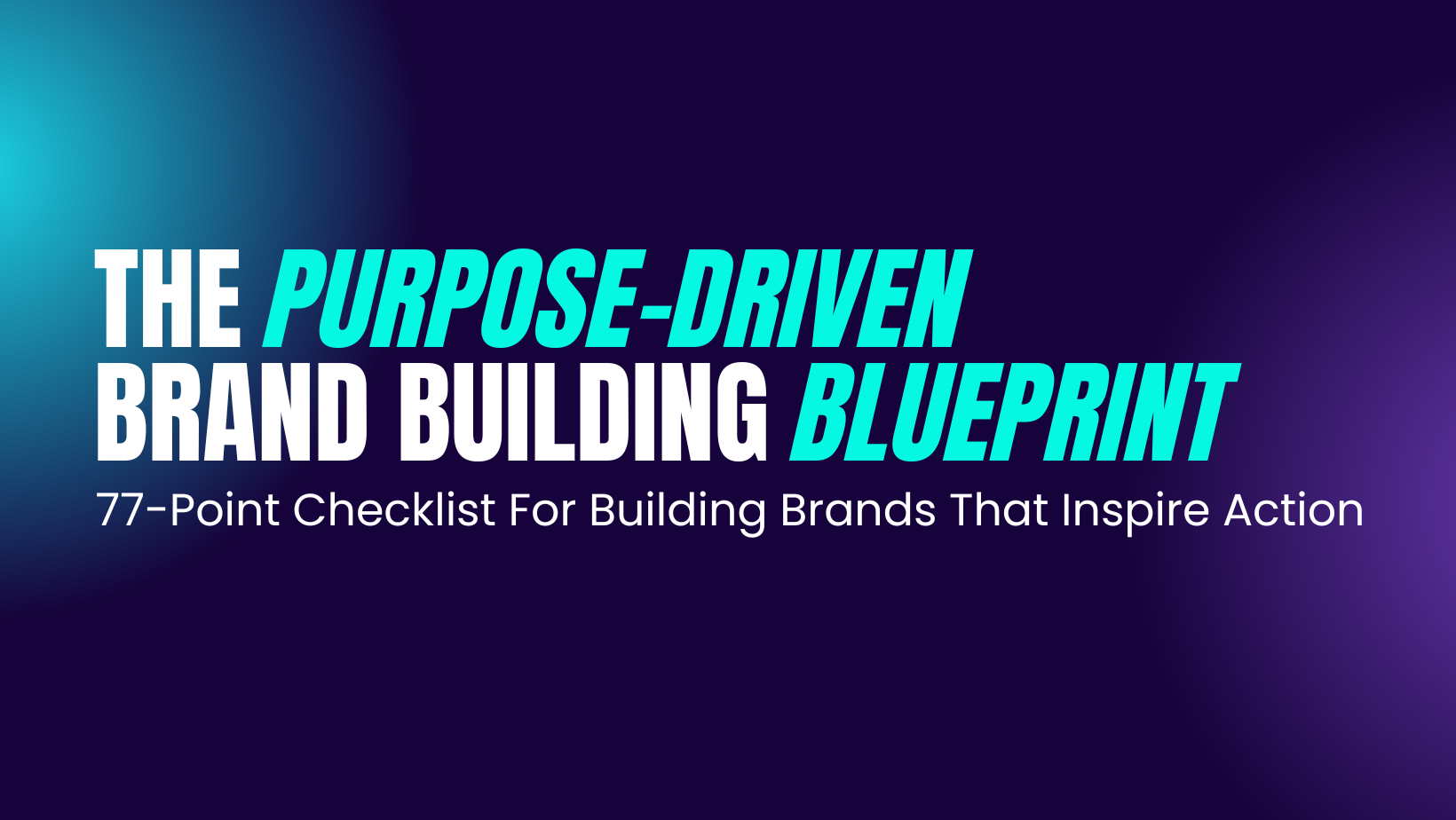The Purpose-Driven Brand Building Blueprint

In a world where consumers and stakeholders increasingly prioritize social and ethical responsibility, purpose-driven branding is no longer optional—it’s essential. This article is a high-level view of The Purpose-Driven Brand Building Blueprint, a 77-point checklist developed by our team here at HOLY SH*FT! Creative Studio, designs for organizations looking to make a meaningful impact while achieving financial success. Whether you’re running a business, church, or nonprofit, aligning your brand with a clear purpose can drive sustainable growth and engagement.
Understanding the Purpose-Driven Brand Building Blueprint
The Purpose-Driven Brand Building Blueprint is a strategic guide designed to help organizations build brands that connect with their audience and reflect their core mission. It breaks down into four key components: Define, Align, Amplify, and Measure. Each component plays a vital role in ensuring that your brand’s purpose is integrated into every aspect of your operations, from internal culture to external communications.
This framework is particularly valuable for organizations aiming to leverage The Purpose Paradox—the idea that focusing on making a difference can also lead to financial success. Traditional thinking often separates social impact from profitability, but the Purpose Paradox shows that these goals can go hand in hand. By prioritizing purpose alongside profit, organizations can achieve both meaningful impact and financial growth.
1. Define: Articulate Your Brand’s Purpose
The first step in building a purpose-driven brand is to clearly define what your organization stands for. This involves crafting a purpose statement that encapsulates your brand’s mission, values, and impact. A well-defined purpose serves as a guiding star for all decisions and actions, ensuring consistency and authenticity.
How to Define Your Purpose:
- Draft a Purpose Statement: Think about what your organization does best and how it makes a difference in the world. Start with a simple template: “We exist to [solve a problem or meet a need] for [target audience] by [unique value proposition].” For example, a local organic grocery store might state, “We exist to provide fresh, sustainable food for our community by supporting local farmers and reducing our carbon footprint.”
- Engage Stakeholders: Involve your employees, customers, and partners in refining your purpose statement. Ensure that it resonates with everyone involved and truly reflects your brand’s mission. This collaboration helps build consensus and commitment.
- Develop Vision and Mission Statements: Create a vision statement that outlines your brand’s long-term aspirations and a mission statement focusing on current objectives. These statements provide a roadmap for your brand’s journey and highlight the ultimate impact you aim to achieve. For instance, a nonprofit focused on education might have a vision to “create a world where every child has access to quality education” and a mission to “empower communities by providing resources and support for schools.”
- Identify Core Values: Determine the values that define your brand’s beliefs and guide your decisions. Consider what principles are essential for your organization and how they align with your purpose. An example might include a tech company that prioritizes honesty, creativity, and user empowerment as core values.
2. Align: Ensure Consistency Across the Brand
Once you’ve defined your brand’s purpose, the next step is to align all aspects of your organization with this purpose. This includes your operations, culture, and leadership. Alignment ensures that every part of your organization reflects your mission, creating a cohesive and consistent brand identity.
How to Align Your Brand:
- Host Workshops: Conduct workshops with team members to discuss and align on the brand’s purpose and values. These sessions can help ensure everyone is on the same page and working towards the same goals.
- Create Brand Identity Guidelines: Develop guidelines that detail the use of brand elements, such as logos, colors, and fonts. This helps maintain consistency across all communications and materials. Make sure everyone in your organization understands these guidelines and follows them.
- Internal Communication Strategy: Implement a plan for regularly communicating the brand’s purpose and values to your team. Use newsletters, meetings, and digital platforms to keep employees engaged and informed. This helps ensure everyone is aligned with the brand’s mission.
- Lead with Purpose: Train leaders to embody and advocate for the brand’s purpose in their daily actions and decisions. Regularly discuss how leadership can set the tone for a purpose-driven culture. This ensures that leaders consistently promote the brand’s mission.
3. Amplify: Expand Your Brand’s Influence
Amplification involves sharing your brand’s story and purpose with the world. This component focuses on engaging with your audience through targeted marketing, storytelling, and partnerships. By amplifying your purpose, you can reach a broader audience and deepen your impact.
How to Amplify Your Brand:
- Targeted Marketing Campaigns: Create marketing campaigns that speak directly to different groups within your audience. This means understanding their specific needs and interests and crafting messages that resonate with them. Use feedback and information about your audience to tailor these campaigns effectively.
- Purpose-Centric Storytelling: Craft stories that highlight your brand’s journey, mission, and impact. For instance, a clothing brand committed to ethical manufacturing might share stories about the artisans who craft their products and the communities they support. Share these narratives across various platforms, such as social media, blogs, and newsletters, to engage your audience.
- Collaborate with Influencers and Partners: Identify individuals and organizations that share your values and can help amplify your message. Develop partnerships that align with your brand’s purpose and create mutual benefits. Collaborating with well-aligned partners can extend your reach and influence.
- Engage with the Community: Participate in events and initiatives that align with your mission. For example, a health-focused nonprofit could organize local wellness events and workshops to engage with their community. This involvement helps build relationships and reinforces your commitment to making a positive impact.
4. Measure: Evaluate Your Brand’s Impact
The final component of the blueprint is measurement. By tracking and analyzing your brand’s performance, you can assess the effectiveness of your efforts and identify areas for improvement. Measurement demonstrates accountability and commitment to your mission.
How to Measure Your Brand’s Impact:
- Brand Perception Surveys: Conduct surveys to understand how your brand is perceived by your audience. Use this feedback to identify areas for growth and improvement. This helps you understand how well your brand’s purpose is resonating with your audience.
- Analyze Engagement Metrics: Track metrics such as website visits, social media interactions, and sales to gauge the effectiveness of your marketing efforts. Look for patterns and insights that reveal what is working and what might need adjustment.
- Assess Community Impact: Gather testimonials and stories from customers, employees, and community members to highlight your brand’s contributions. Use these stories to reinforce your commitment to making a difference and to showcase the real-world impact of your efforts.
- Continuous Improvement: Regularly review your brand’s performance and seek ways to enhance your strategies. Stay adaptable and open to feedback to ensure ongoing alignment with your purpose. This ongoing assessment helps you remain true to your mission while adjusting to new challenges and opportunities.
Why Purpose-Driven Branding Matters
Purpose-driven branding isn’t just a framework; it’s a strategic advantage in today’s market. Brands that align with a clear purpose attract more loyal customers, engage more motivated employees, and build stronger community ties. This alignment creates a ripple effect, where the impact of your brand extends beyond immediate business goals to foster long-term relationships and drive systemic change.
This framework is especially relevant for ethical businesses, churches, and nonprofits. Whether you’re building from scratch, looking to rebuild or revamp your brand, or simply fine-tuning your existing strategies, this blueprint provides a high-level overview of the steps necessary to align purpose with practice.
The Purpose-Driven Brand Building Blueprint is available for free download at the top of this page. This guide serves as a starting point for organizations eager to embrace the Purpose Paradox and transform their brand into a force for good. For those interested in a deeper dive, explore more about the Purpose Paradox here.
Whether you’re a business, church, or nonprofit, HOLY SH*FT! Creative Studio is here to support your journey toward impactful branding. Connect with us to learn more about how we can help you achieve your goals.

